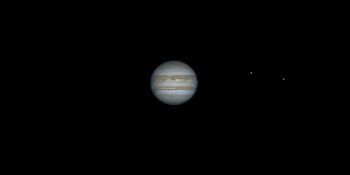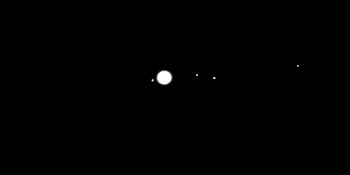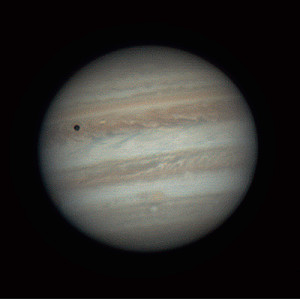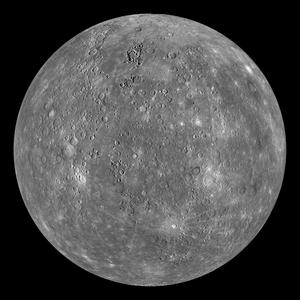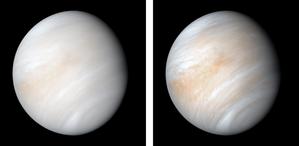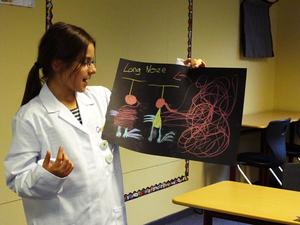Glossary term: ग्रह (प्लैनट)
Description: अंतर्राष्ट्रीय खगोलीय संघ के अनुसार, ग्रह एक तारे या तारे के अवशेष की परिक्रमा करने वाला एक खगोलीय पिंड है, जो इतना बड़ा हो सकता है कि अपने गुरुत्वाकर्षण से लगभग गोलाकार हो सकता है, लेकिन इतना बड़ा नहीं कि थर्मोन्यूक्लियर संलयन से गुजर सके। इस खगोलीय पिंड के गुरुत्वाकर्षण खिंचाव को अन्य खगोलीय पिंडों को अपनी कक्षा से बाहर खींचना चाहिए। ये वस्तुएं पास के सूर्य की रोशनी से चमकती हैं। उनके पास अपना स्वयं का प्रकाश नहीं है, लेकिन वे अवरक्त तरंग दैर्ध्य में प्रकाश उत्सर्जित करते हैं। हमारे सौरमंडल में आठ ग्रह सूर्य की परिक्रमा करते हैं। ग्रह मूल रूप से चट्टानी वस्तुएं हो सकते हैं, जैसे आंतरिक ग्रह - बुध, शुक्र, पृथ्वी और मंगल - या ज्यादातर तरल और गैसीय बाहरी ग्रहों - बृहस्पति, शनि, यूरेनस और नेपच्यून की तरह छोटे ठोस कोर हो सकते हैं। सौर मंडल के बाहर के ग्रहों को संक्षेप में एक्स्ट्रासोलर ग्रह या एक्सोप्लैनेट कहा जाता है।
Related Terms:
- पृथ्वी
- Exoplanet
- Gas Giant
- Giant Planet
- Ice Giant
- International Astronomical Union
- Jupiter
- Mars
- Mercury
- Neptune
- Nuclear Fusion
- Outer Planets
- Saturn
- Solar System
- Terrestrial Planet
- Uranus
- Venus
See this term in other languages
Term and definition status: The original definition of this term in English have been approved by a research astronomer and a teacher The translation of this term and its definition is still awaiting approval
The OAE Multilingual Glossary is a project of the IAU Office of Astronomy for Education (OAE) in collaboration with the IAU Office of Astronomy Outreach (OAO). The terms and definitions were chosen, written and reviewed by a collective effort from the OAE, the OAE Centers and Nodes, the OAE National Astronomy Education Coordinators (NAECs) and other volunteers. You can find a full list of credits here. All glossary terms and their definitions are released under a Creative Commons CC BY-4.0 license and should be credited to "IAU OAE".
If you notice a factual or translation error in this glossary term or definition then please get in touch.
Related Media
Jupiter's Rotation, by Vishal Sharma, India
Credit: Vishal Sharma/IAU OAE
License: CC-BY-4.0 Creative Commons Attribution 4.0 International (CC BY 4.0) icons
Jupiter Moons Movie2, by Nicolas Hurez, Paul-Antoine Matrangolo, and Carl Pennypacker, United States of America
Credit: Nicolas Hurez, Paul-Antoine Matrangolo and Carl Pennypacker/IAU OAE
License: CC-BY-4.0 Creative Commons Attribution 4.0 International (CC BY 4.0) icons
Jupiter, Io and its shadow, by Ralf Burkart, Germany
Credit: Ralf Burkart/IAU OAE
License: CC-BY-4.0 Creative Commons Attribution 4.0 International (CC BY 4.0) icons
Mercury
Credit: NASA/Johns Hopkins University Applied Physics Laboratory/Carnegie Institution of Washington credit link
License: PD Public Domain icons
Venus in visible light
Credit: NASA/JPL-Caltech credit link
License: PD Public Domain icons
Related Activities
Design Your Alien
astroEDU educational activity (links to astroEDU website) Description: Design an alien life form suited for an extra-terrestrial world.
License: CC-BY-4.0 Creative Commons Attribution 4.0 International (CC BY 4.0) icons
Tags:
Life
, Environment
, Extra-terrestrial
, Art
, Creativity
, Hands-on
, Alien
Age Ranges:
8-10
, 10-12
Education Level:
Primary
, Secondary
